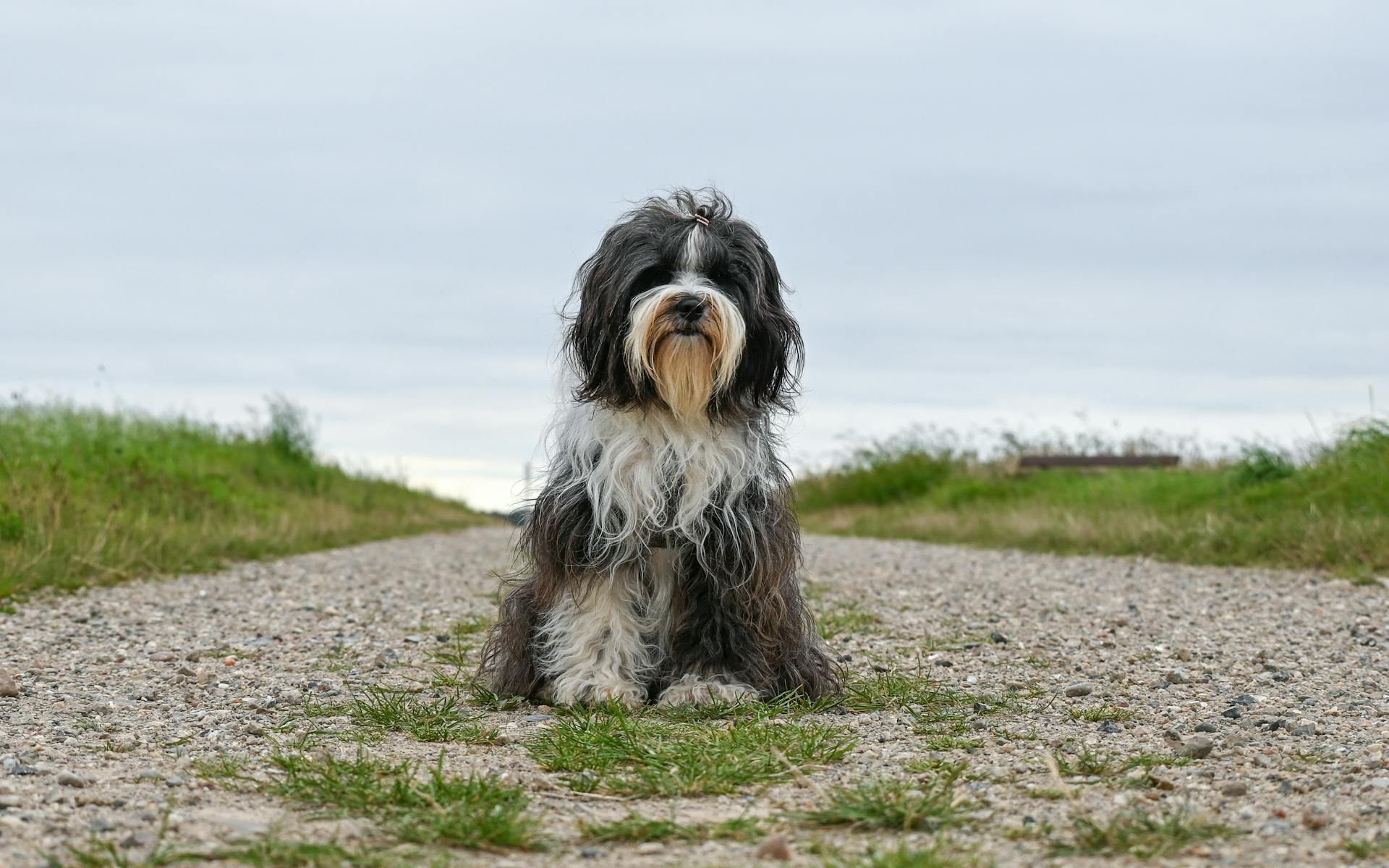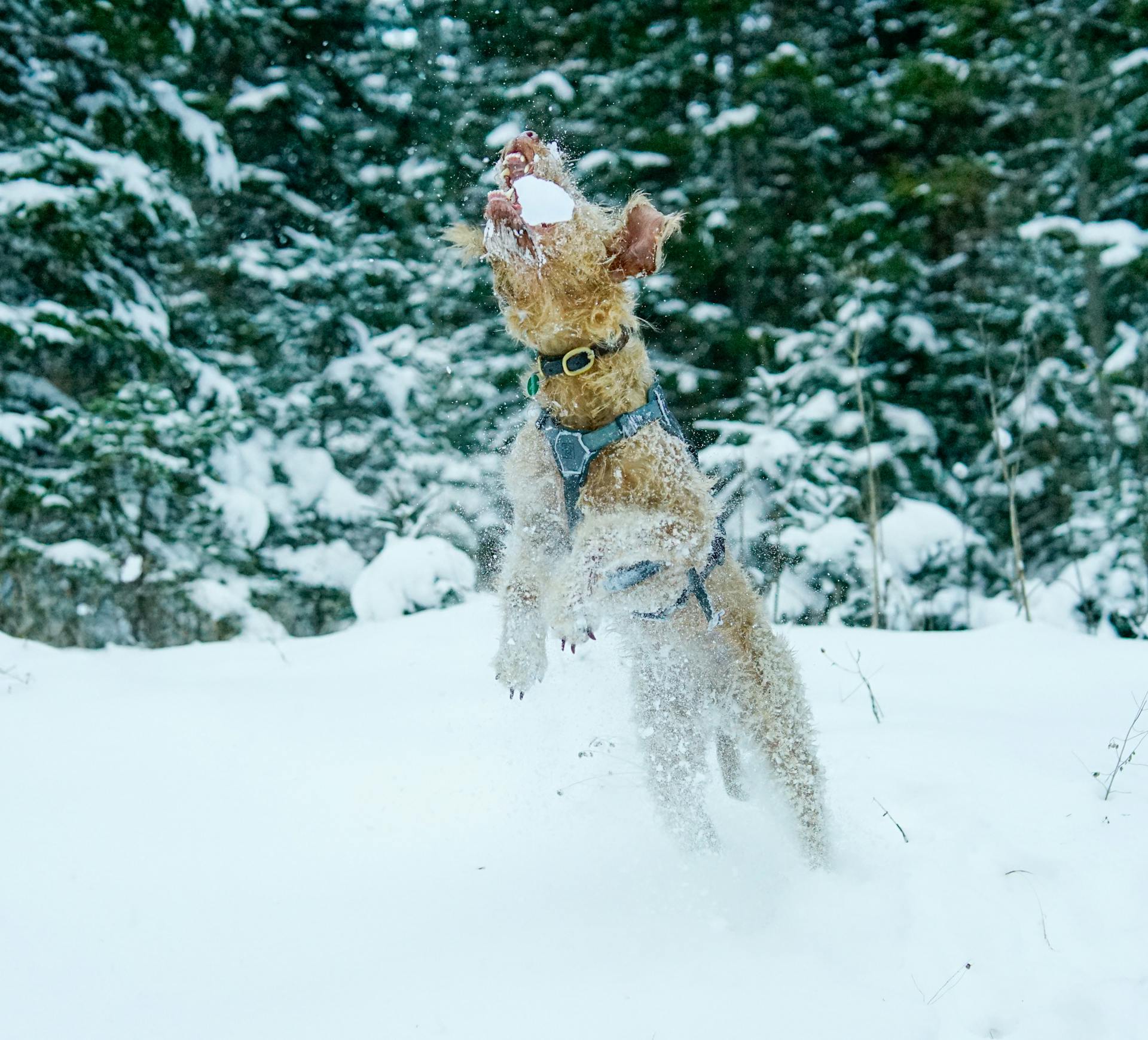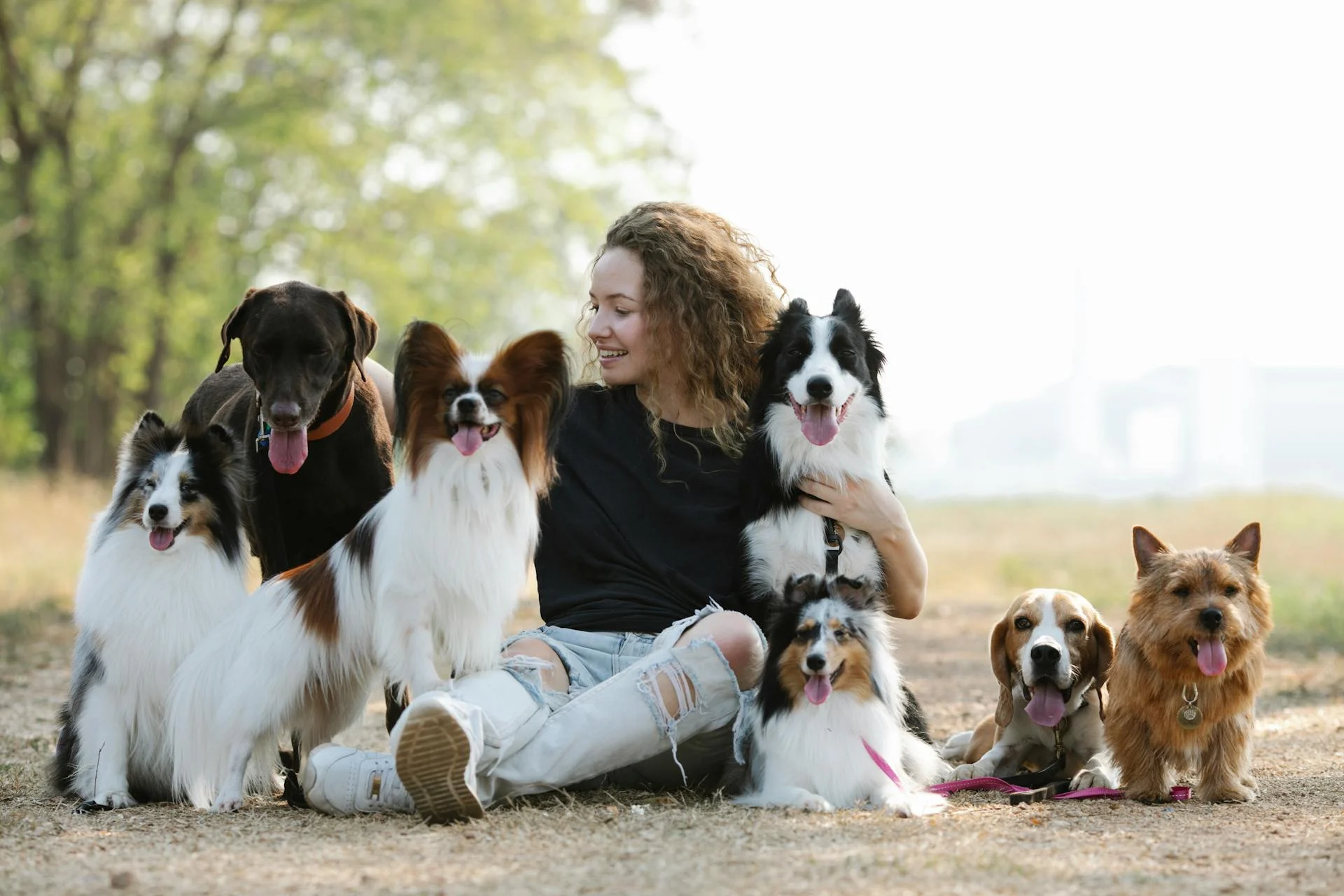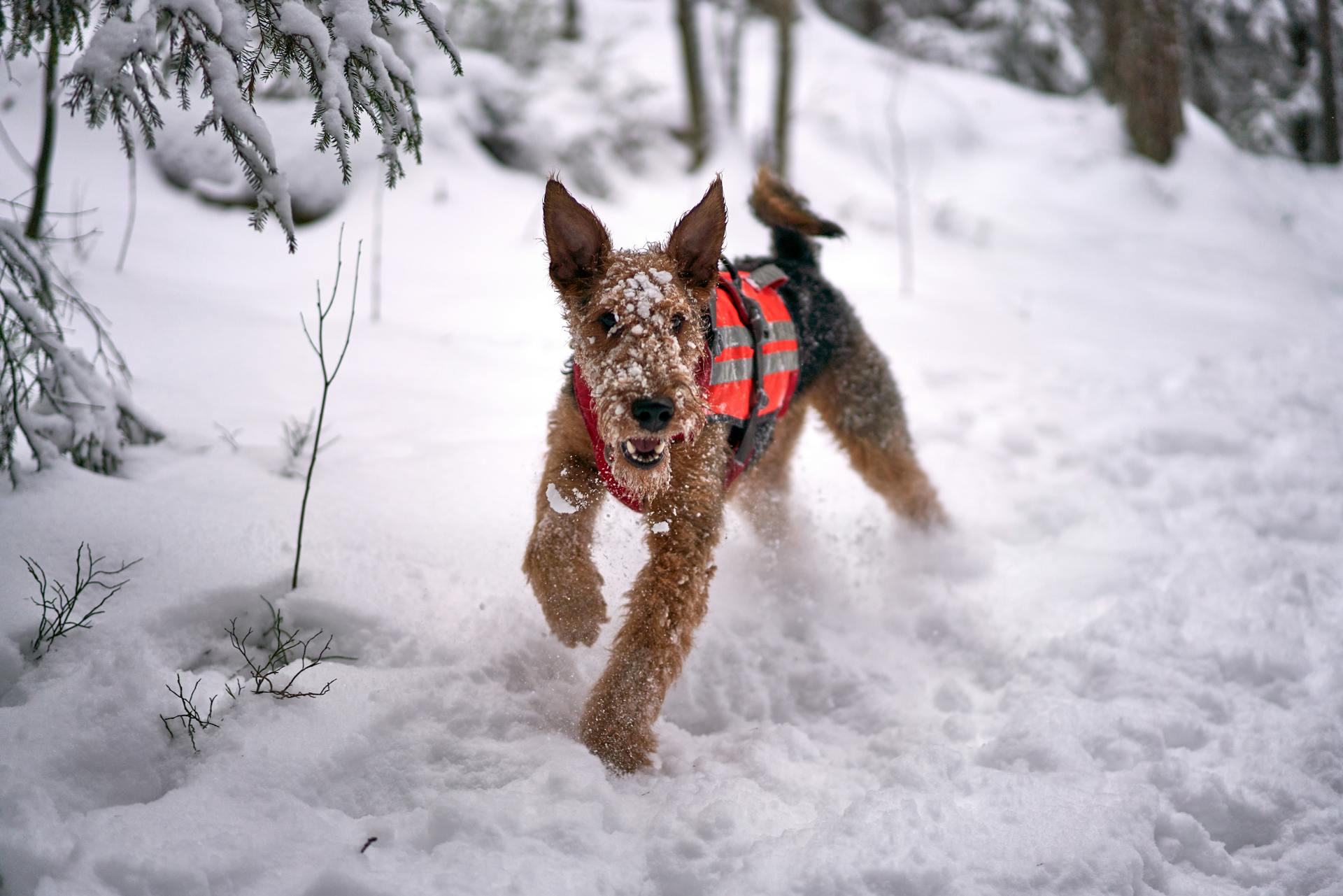
Working terriers have a rich history that dates back to the 18th century in England. They were bred to hunt small game like foxes, badgers, and rabbits.
Their purpose was to "go to ground", meaning they'd chase and dig after their prey, often in underground burrows. This required a unique combination of physical and mental abilities.
Terriers are known for their fearlessness, intelligence, and high energy levels. They're often described as "gamey", meaning they have a strong prey drive and will pursue their quarry with determination.
These characteristics make them well-suited for their original purpose, but also require careful handling and training to prevent problems like excessive barking and digging.
Recommended read: Bull Terrier Purpose
Terrier Breeds
Terrier breeds can be either pedigree or non-pedigree, and it's not necessary for them to be pedigree to be good working terriers.
Fell terriers and patterdale terriers are examples of non-pedigree working terriers, bred from good working terrier genes.
Some terrier breeds are pedigree, such as the Parsons Jack Russell, Border terrier, and Bedlington Terrier, which are often shown at Crufts.
Earthdogs
Working terriers are often referred to as earthdogs, and they're incredibly skilled at their job. Their primary role is to clear farms of vermin such as rats and other small creatures that can cause damage to crops and buildings.
In the UK, working terriers are still used for this purpose, and their skills are on full display when you watch videos of them in action. If you type "working terriers hay bales" into YouTube, you'll see what I mean - these dogs are fast, agile, and seem to love their work.
One of the key characteristics of a working terrier is its small chest size, which allows it to navigate through narrow underground tunnels with ease. This is crucial for their job, as they often need to follow their quarry into tight spaces.
A small chest size is not the only requirement for a working terrier, though - they also need to have essential gameness, a good nose, and the ability to problem-solve to avoid coming to harm underground. This is essential for their safety, as well as the safety of the people working with them.
A unique perspective: Tiny Yorkshire Terrier Puppy
In the UK, working terriers are exempt from the hunting ban, as long as they're used for ratting, rabbiting, or other forms of vermin control. However, it's essential to follow the rules and regulations surrounding the use of dogs for hunting, and to ensure that any images or videos shared online are legal and humane.
Here are some key requirements for working terriers:
- Small chest size for navigating narrow tunnels
- Essential gameness for following quarry underground
- Good nose for tracking and locating prey
- Ability to problem-solve to avoid coming to harm
Terrier Breeds
Working terriers are incredibly versatile and can be used for a variety of tasks, from clearing farms of vermin to tracking due to their strong sense of smell.
The Parsons Jack Russell is a great example of a pedigree working terrier, bred for their high energy and excellent ratting abilities.
Fell terriers are a mix of several types of terrier, often used on farms and the 'fells', and are essentially a long-legged mongrel type terrier.
Patterdale terriers were originally bred in the Lake District of Cumbria for hunting vermin such as foxes, rabbits, and rats.
Additional reading: Game Bred American Pit Bull Terrier
Terrier work is a traditional and effective way to control vermin, with 9% of foxes killed by UK gamekeepers following the use of terriers, according to a 1994 survey.
Border terriers, on the other hand, were originally bred for fox hunting, but are now used for general clearing of farmland and alerting to intruders.
Jack Russells are instantly recognisable due to their tri-colour coat and mask-like face, and are high energy terriers that make excellent ratting dogs and guard dogs.
Terrier Characteristics
Working terriers are known for their sturdy build, but what exactly makes them well-suited for their job? The most important working terrier characteristics include speed, prey drive, and sturdiness.
A small chest size is also crucial for navigating narrow underground tunnels, allowing the dog to reach its quarry without extensive digging and fatigue. In fact, smaller dogs are often more effective in these situations, as they can fit through tight spaces and avoid being bitten by the prey.
Prey drive is a natural instinct for terriers, which means they have a strong desire to chase small animals like rodents and vermin. This is why they're often used for tracking and clearing farms of pests.
For your interest: Breeds of Small White Dogs
Terrier Characteristics
Working terriers are known for their speed, with the ability to navigate through narrow underground tunnels and catch their quarry without extensive digging or fatigue.
Their prey drive is a natural instinct, not something that needs to be taught, and it's what drives them to chase small animals like rodents and vermin.
A small chest size is a critical physical attribute for a working terrier, allowing them to fit through tight spaces and reach their quarry without difficulty.
In fact, smaller dogs are often more effective at this task, as they can avoid being bitten and are less likely to get stuck in narrow tunnels.
Larger dogs, on the other hand, can face difficulties maneuvering through tight bends in tunnels, requiring frequent intervention from handlers.
Their sturdiness is also a key characteristic, with some breeds like fell terriers and Patterdales being known for their "hard as nails" reputation.
This means they'll relentlessly go after prey, even when it fights back, making them a valuable asset for farmers and hunters alike.
Their strong sense of smell also makes them useful for tracking, and their gameness ensures they'll stick to the task at hand, even in challenging situations.
Consider reading: Small Breed Dogs That like Water
Size
The size of a terrier is particularly important if they're working underground or near burrows. Their size needs to be appropriate to the job that they do and relative to their prey.
A terrier's size can vary depending on the specific breed and job requirements, with some needing to be quite small to navigate tight spaces.
In the UK, the ideal height for a cairn terrier is 11-12 inches high at the withers (shoulders), making them sturdy and well-proportioned dogs.
Terrier Tail Docking Debate
Docking the tails of working terriers is a contentious issue. Some argue it's unnecessary for pet terriers, but it can be beneficial for working dogs when done properly.
If done by a vet who certifies the docking within the first 5 days of life, tail docking can minimize injury to the tail in working terriers. It can also prevent them from catching their tail in bushes.
The decision to dock a working terrier's tail ultimately depends on the individual dog and its intended use.
Terrier Care
Terriers require regular exercise to stay happy and healthy, so aim for at least 30 minutes of physical activity per day.
Their short coats require minimal grooming, but they do need regular nail trimming and ear cleaning to prevent matting and infection.
A balanced diet is essential for working terriers, with a mix of protein-rich foods and complex carbohydrates providing the energy they need for their physically demanding jobs.
Requirements for a Terrier
A small chest size is crucial for a working terrier, as it allows them to navigate through narrow underground tunnels with ease. This is because a smaller chest size enables them to reach their quarry without extensive digging and without getting too fatigued.
Speed is also an essential characteristic of a working terrier, as it allows them to keep up with their prey and avoid being caught. This is especially important when working with two animals underground, where maintaining a flow of air is vital to avoid asphyxiation.
A good nose is another vital requirement for a working terrier, as it helps them track down their quarry and stay on the scent. This is especially important when working in tight spaces where visibility is limited.
Essential gameness is also a must-have for a working terrier, as it allows them to stay focused and driven in the face of challenges. This is crucial when working underground, where the terrier may encounter obstacles and tight spaces that require problem-solving to overcome.
Problem-solving skills are also essential for a working terrier, as they need to be able to navigate through complex tunnel systems and avoid coming to harm. This may involve thinking on their feet and finding creative solutions to unexpected problems.
Worth a look: When Do Yorkshire Terriers Go into Heat
Tools and Technique
As a terrier owner, it's essential to understand the tools and techniques involved in caring for these energetic dogs. The tools used for terrier work have remained largely unchanged for over 400 years.
A good terrier man typically uses a small-chested and game-working terrier, which is a specific type of hunting dog. A round point shovel is also a crucial tool for terrier work.
The digging bar is another essential piece of equipment, used to help the dog dig and excavate. Fox nets are also used to remove the quarry, or the animal being hunted.
The only modern piece of equipment that has been introduced to terrier work is the electronic radio collar, which helps locate the dog underground and increase safety.
Terrier men use a variety of tools to clear away hedges and brambles, including a brush hook. A snare or a gun or blunt instrument is used to dispatch the quarry once it has been removed.
Here's a list of tools commonly used in terrier work:
- Small-chested and game-working terrier
- Round point shovel
- Digging bar
- Brush hook
- Fox nets
- Electronic radio collar
- Snare or gun or blunt instrument
Terrier History and Purpose
Cairn Terriers were bred for a very specific purpose: to hunt vermin. Their original role was to chase and flush out small game like rodents and rabbits.
Their compact size and agility allowed them to go into tight spaces underground and between rocks in pursuit of their prey. Their front feet are well padded and larger than their back feet, perfect for digging.
Their double coat helps protect them from harsh weather, and their powerful muzzle and scissor bite enable them to grasp onto roots or prey. Their strong, upright tail acts like a flag to help locate them when they're underground or in tight spaces.
Some key features of working terriers include:
- Compact size and agility
- Well-padded front feet for digging
- Double coat for protection from harsh weather
- Powerful muzzle and scissor bite
- Strong, upright tail
Introduction to Terriers
Terriers have been bred for centuries to perform specific tasks, primarily hunting and vermin control. Their original purpose was to hunt and kill foxes, but this is no longer allowed in England since the Hunting Act of 2004.
Working terriers have adapted to new roles, such as clearing farms of rats and vermin. They are also used for 'bushing' or clearing bushes of unwanted animals.
In the UK, working terriers are often seen in action on YouTube, with videos like "Severn Valley Ratters – Mayhem in the Bales!" showcasing their speed and agility. These dogs clearly enjoy their work!
There are two main roots of working terriers: colored dogs from Scotland and white dogs from England and Wales. This diversity has given rise to various Kennel Club breeds and types of working terriers.
The Fell Terrier is an original non-pedigree-colored working dog from the north, which has spawned breeds like the Border Terrier and the Lakeland Terrier. Today, only the Border Terrier is occasionally found working in the field.
Working Fell Terriers can be brown, black, red, or black and tan, and may have a smooth, wire, or broken coat. They're often referred to as Fell Terriers, working Lakelands, or Patterdale Terriers.
You might like: Fell Terrier Cross Jack Russell
Purpose Bred
Terriers were originally bred for specific jobs, such as hunting and clearing farms of vermin. Their unique features and abilities were developed to suit these tasks.
One of the key characteristics of terriers is their small and agile size, which allows them to fit into tight spaces like underground dens and crevices between rocks. This is essential for their original role of hunting and killing vermin.
Their front feet are well padded and larger than their back feet, making them perfect for digging. The slight turn out of their front feet also allows them to push dirt behind them when digging in tight spaces.
A double coat with a harsh outer and soft inner coat helps protect terriers from wet and cold weather. This is especially useful for their original job of hunting vermin in damp and cold environments.
Terriers have a powerful muzzle and scissor bite, which allows them to get a firm grasp on roots or prey. Their strong, well-set, upright tail also acts as a flag to help localize the dog when it's underground or between rocks.
Their loud barks were desirable to help the handler keep track of their location. This is especially important when the dog is underground or in a dense area.
Here are some key features of terriers that were developed for their original jobs:
- Small and agile size for fitting into tight spaces
- Well-padded front feet for digging
- Double coat for protection from wet and cold weather
- Powerful muzzle and scissor bite for grasping roots or prey
- Strong, well-set, upright tail for localization
- Loud barks for keeping track of location
Terrier for Vermin Control
Terriers have been used to control vermin for centuries, with their strong sense of smell and prey drive making them ideal for the job.
Originally bred to hunt foxes, rabbits, and rats, terriers have been used to clear farms of unwanted pests. They're also good guard dogs and useful farm animals.
In the UK, working terriers are still used to clear farms of vermin such as rats and for 'bushing' or clearing the bushes of vermin. They're also sometimes used for tracking due to their strong sense of smell.
A team of terriers, when coupled with an enthusiastic digger, can control red foxes, raccoons, and groundhogs on small farms where their presence might be a problem for chickens, geese, wild bird populations, and crop production.
According to a 1994 survey by the British Association for Shooting and Conservation, 9% of foxes killed by UK gamekeepers were killed following the use of terriers.
For another approach, see: Rat Terrier Catching Rats
Terrier work is considered an ideal way to control certain nuisance wildlife in farm countries due to its selectivity and lack of danger to unseen young in dens.
Terriers are more effective at controlling vermin when they're small in size, as they can navigate through narrow underground tunnels with ease.
Here are some of the key characteristics of a working terrier that make them effective at vermin control:
- Small chest size for navigating narrow underground tunnels
- Strong sense of smell and prey drive
- Ability to problem-solve to avoid coming to harm underground
- Essential gameness
- Good nose
Terrier Appearance and Health
Terrier appearance is just as important as their working ability. A sturdy, strong, and well-balanced dog is what you should expect from a Cairn terrier.
Their expression is often described as 'foxy' with bright, alert eyes that shine with intelligence. This is a characteristic of the breed that's hard to ignore.
The Cairn terrier's movement is smooth and effortless, with a level top line that's a testament to their athleticism. They should never look delicate or ponderous.
Their ears are naturally pricked and upright, adding to their alert and perky expression. The fur on the upper half to two-thirds of the ear is usually kept short to maintain this look.
A fresh viewpoint: Yorkie Dog Personality
A Cairn terrier's tail is natural and stands straight up, resembling an inverted carrot at the end of their spine. This is a distinctive feature of the breed.
The Cairn terrier's coat is double-layered, with harsh outer hair and a soft undercoat. This provides excellent dirt and water repellency as well as insulation in cold, damp weather.
Here are the different color variations of the Cairn terrier:
- Red
- Wheaten
- Cream
- Grey
- Brindle (often described as 'tiger-stripes')
It's worth noting that predicting the adult coat color of a Cairn terrier puppy can be difficult, as coat color changes throughout life.
Terrier Recognition
The AWTA recognizes a specific group of breeds for competition in den trials, including Australian, Bedlington, Border, Cairn, Cesky, and many others.
These recognized breeds, such as the Dachshund, must be of suitable size to fit in a nine-inch artificial earth.
Individual Feist, Rat terriers, and terrier-crosses can also be entered in den trials if they're of suitable size.
For hunting and above ground hunting tests, the AWTA recognizes a broader range of breeds, including those from the terrier group of major national all-breed kennel clubs.
In the certificate class, dogs of suitable size can compete in a miscellaneous category, which may be divided into short-legged and long-legged categories at the discretion of the trial chairman.
Frequently Asked Questions
What is the smallest working terrier?
The smallest working terrier is the Norfolk and Norwich Terrier. These two breeds are the smallest of the working terriers.
Featured Images: pexels.com


